Charles E W Bean, Diaries, AWM38 3DRL 606/1/1 - October - December 1914 - Part 11
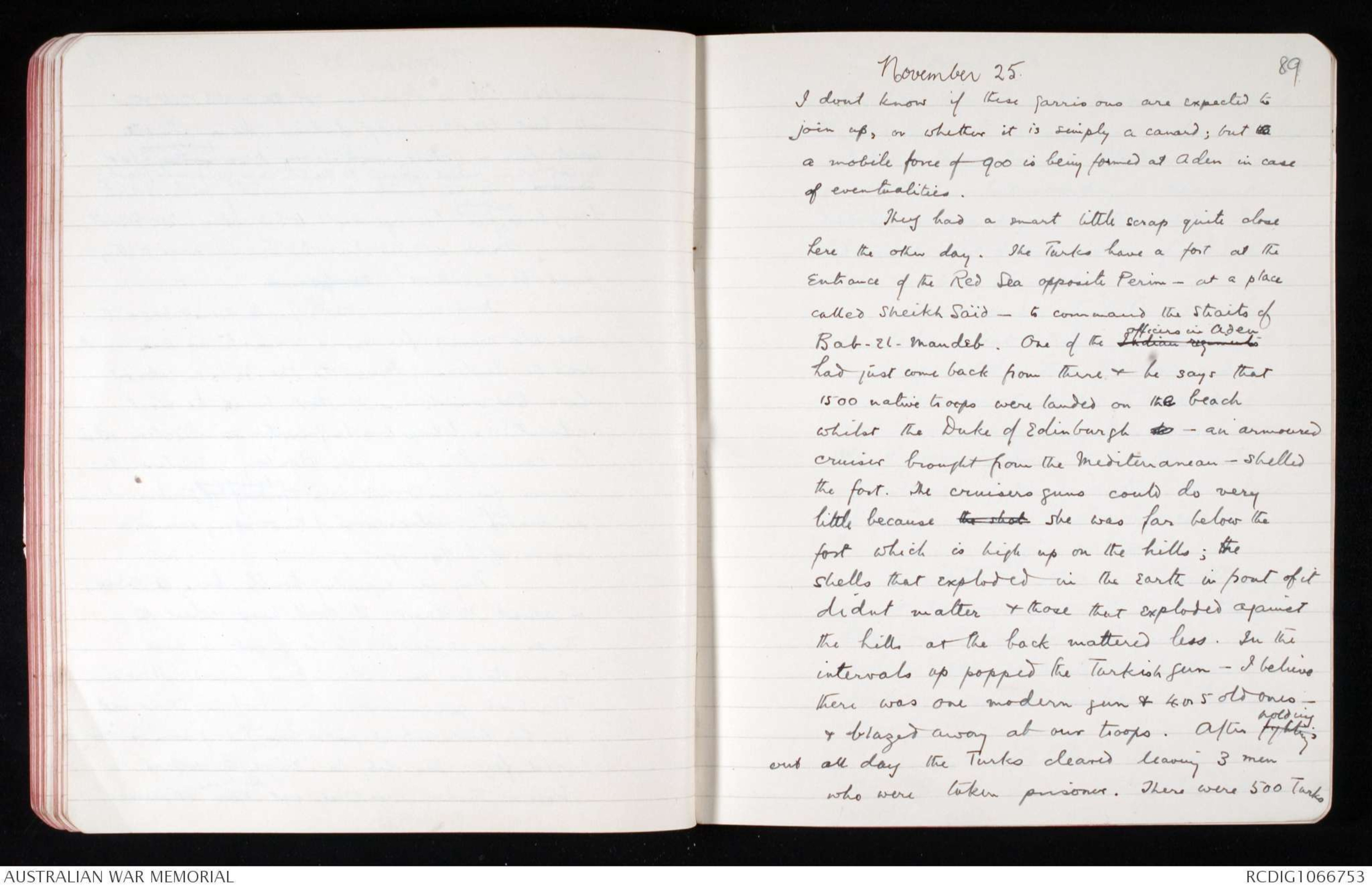
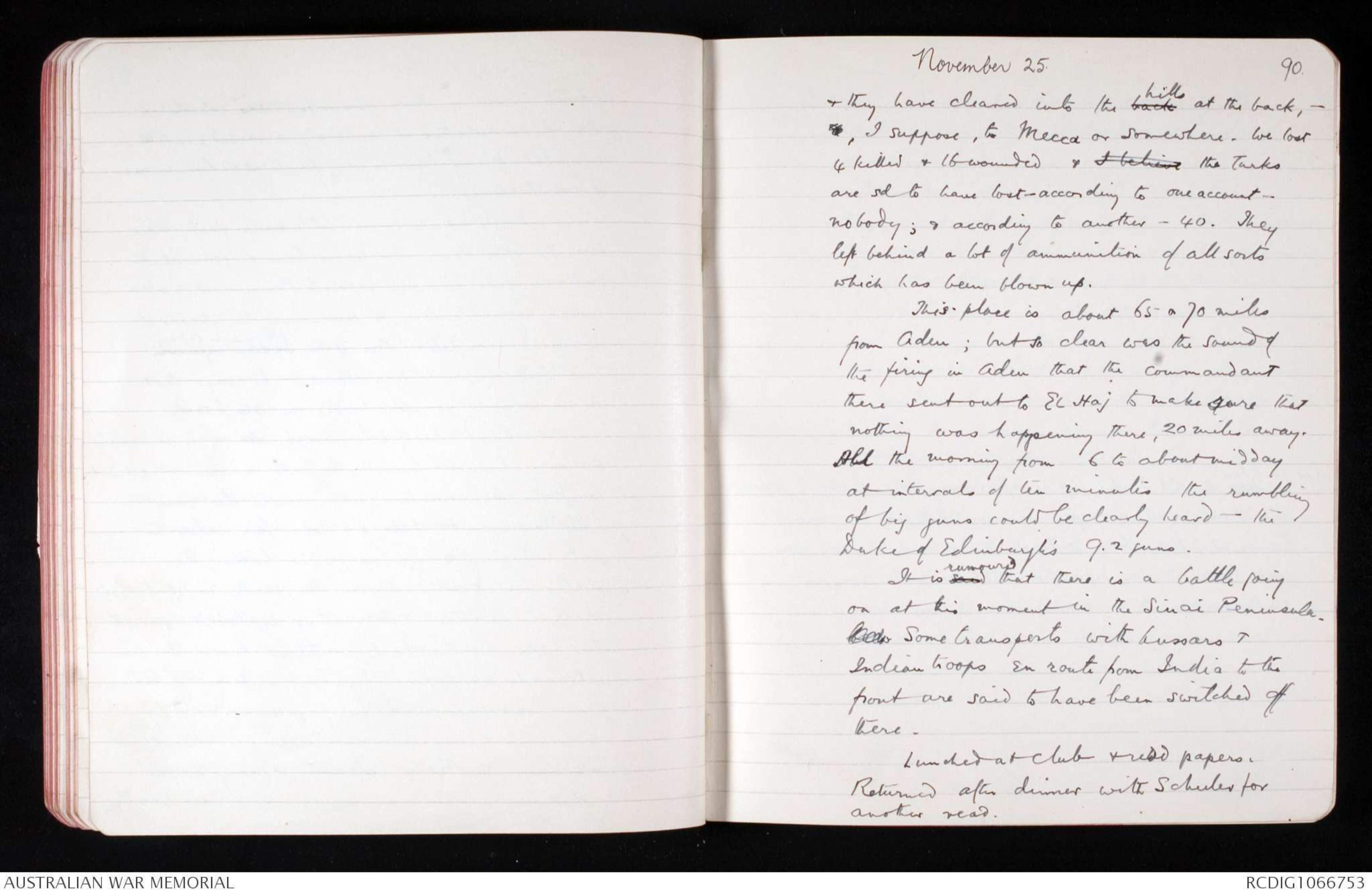
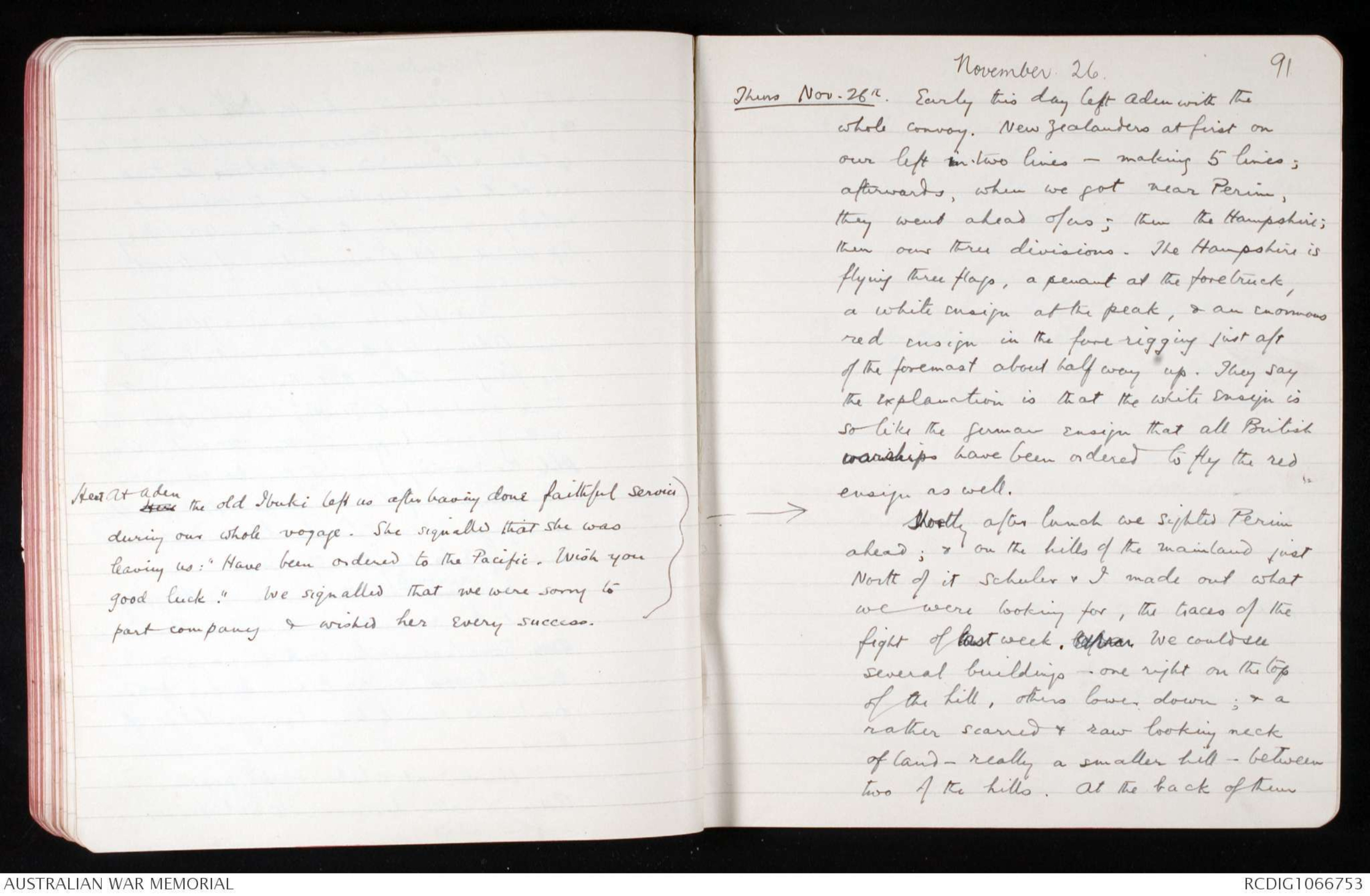
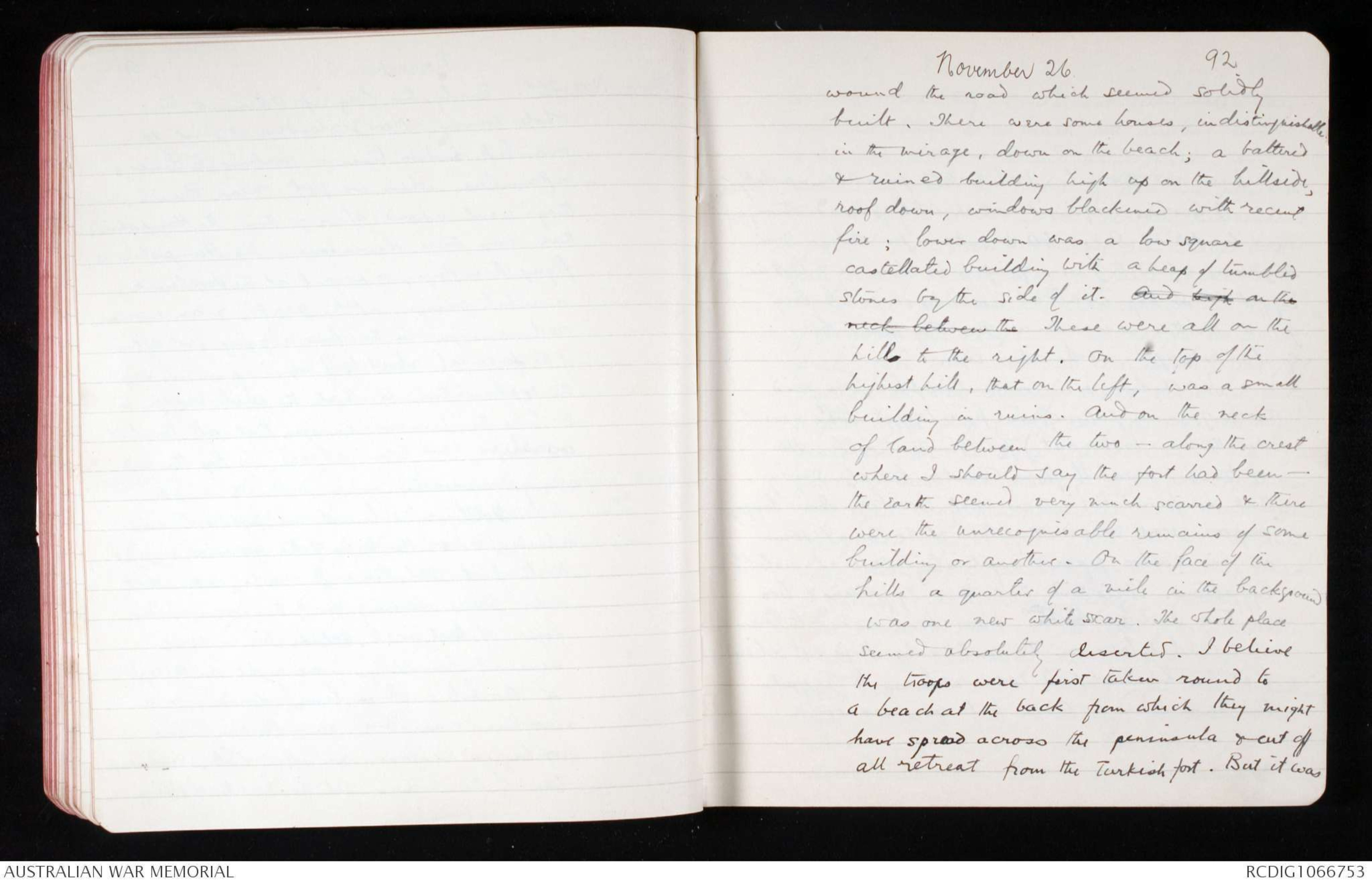
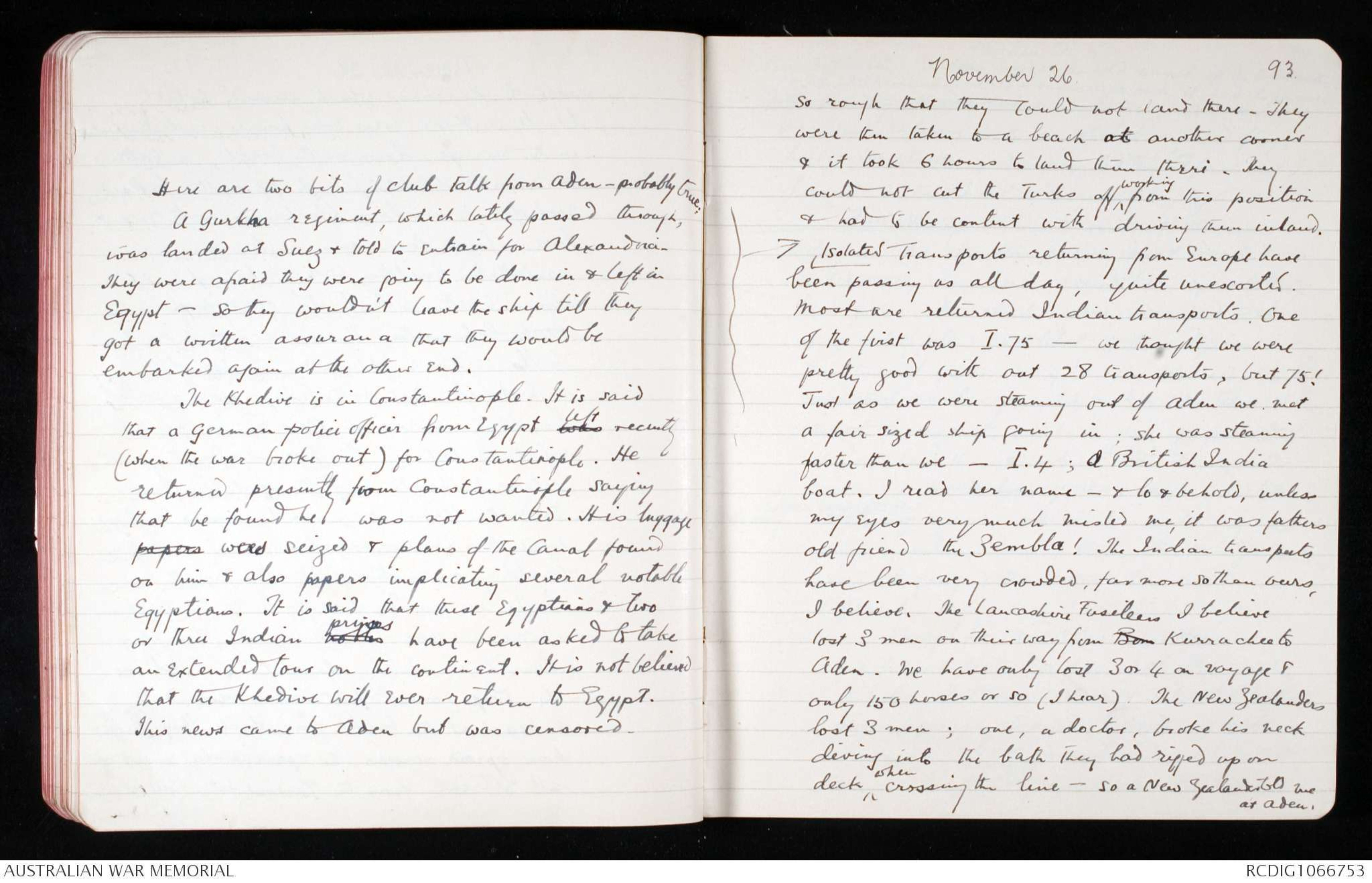
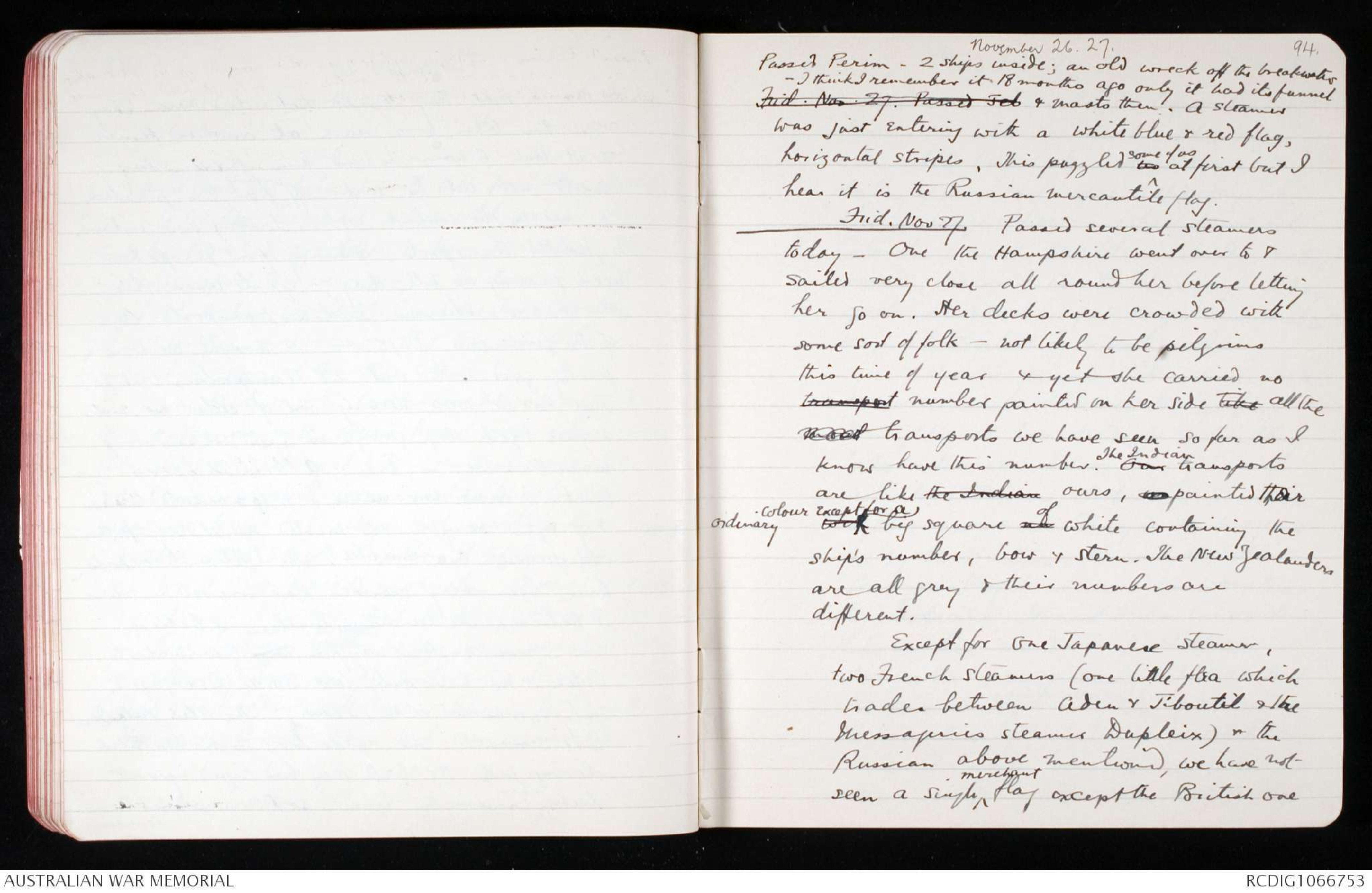
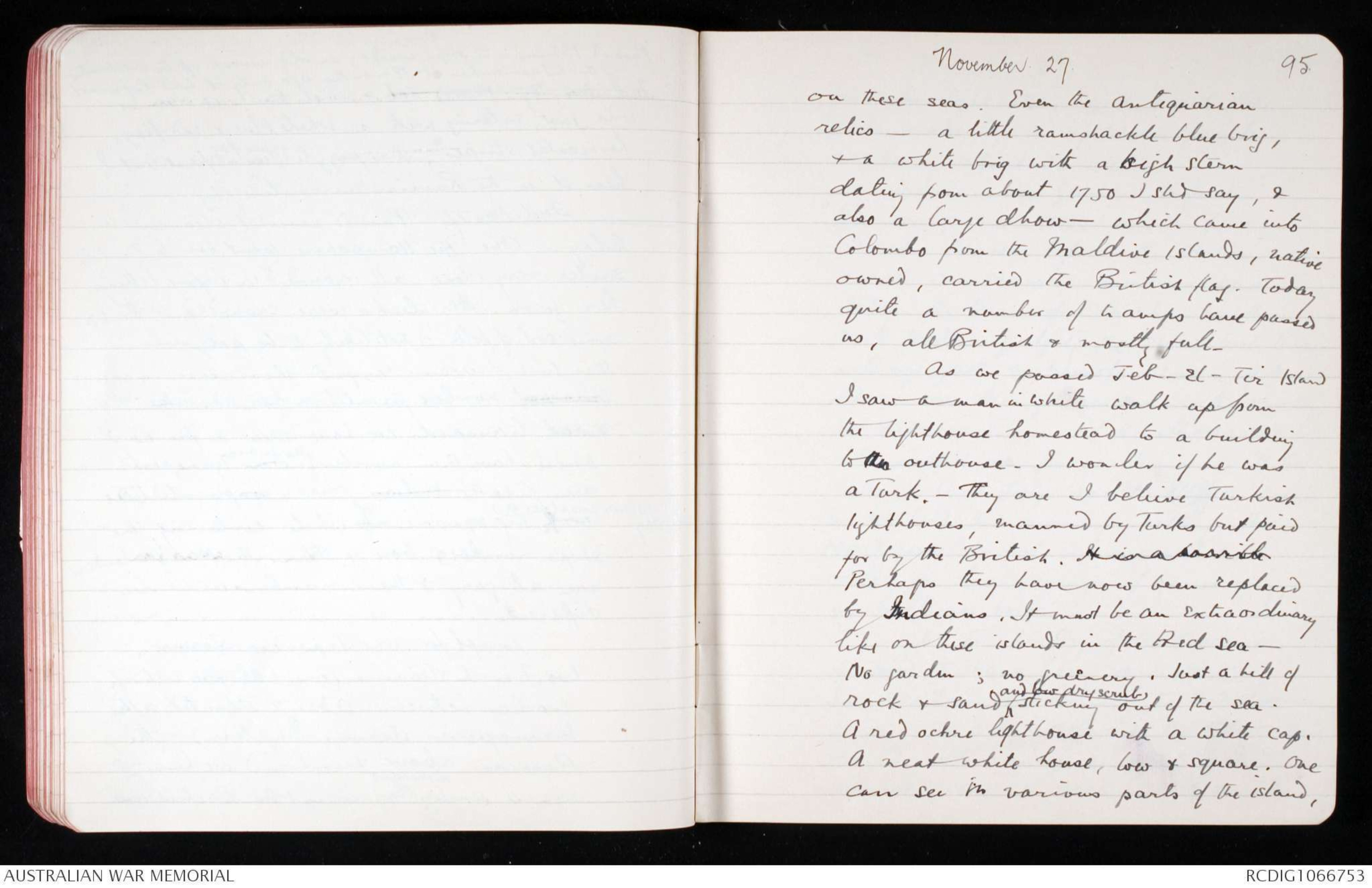
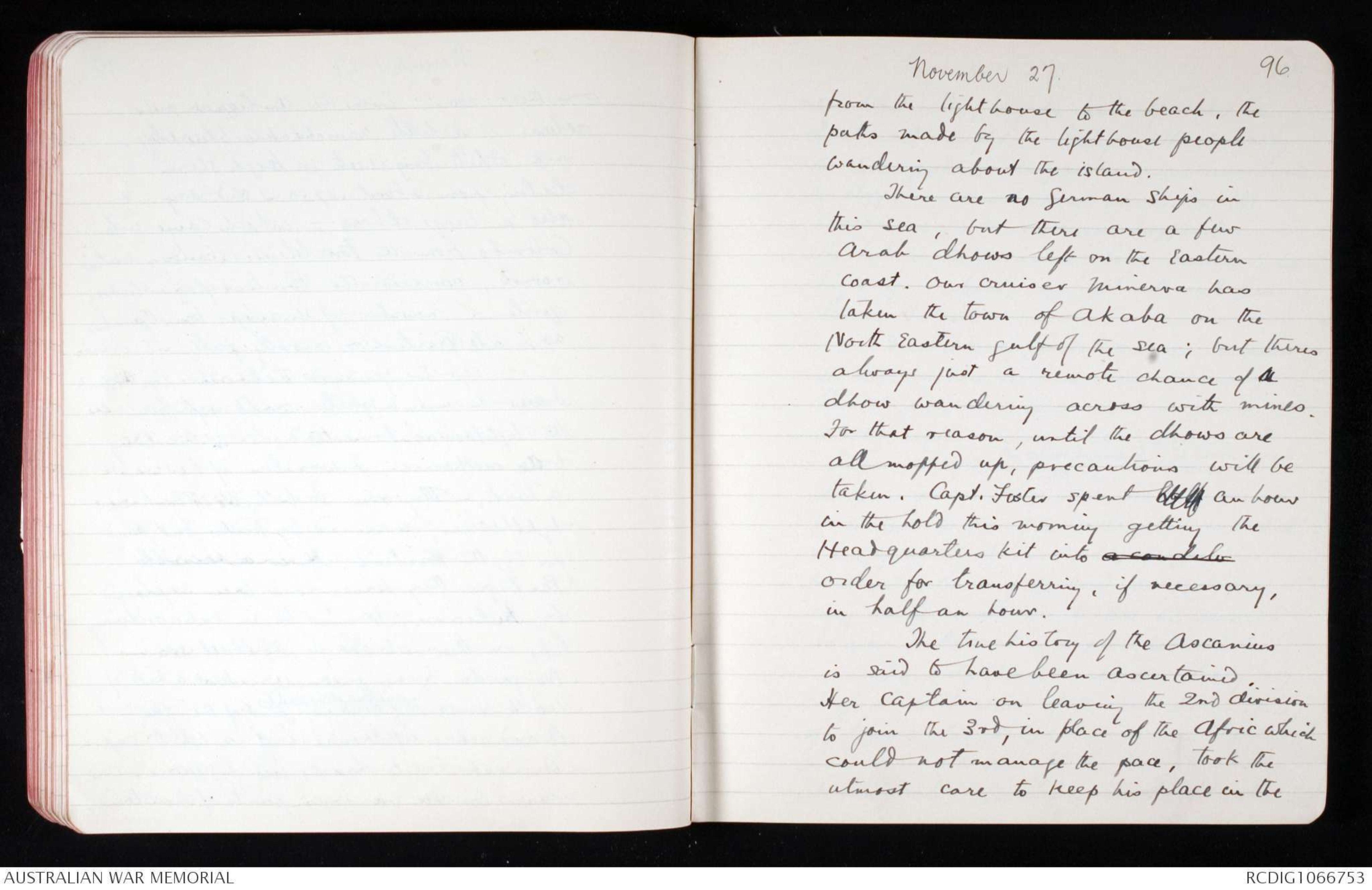
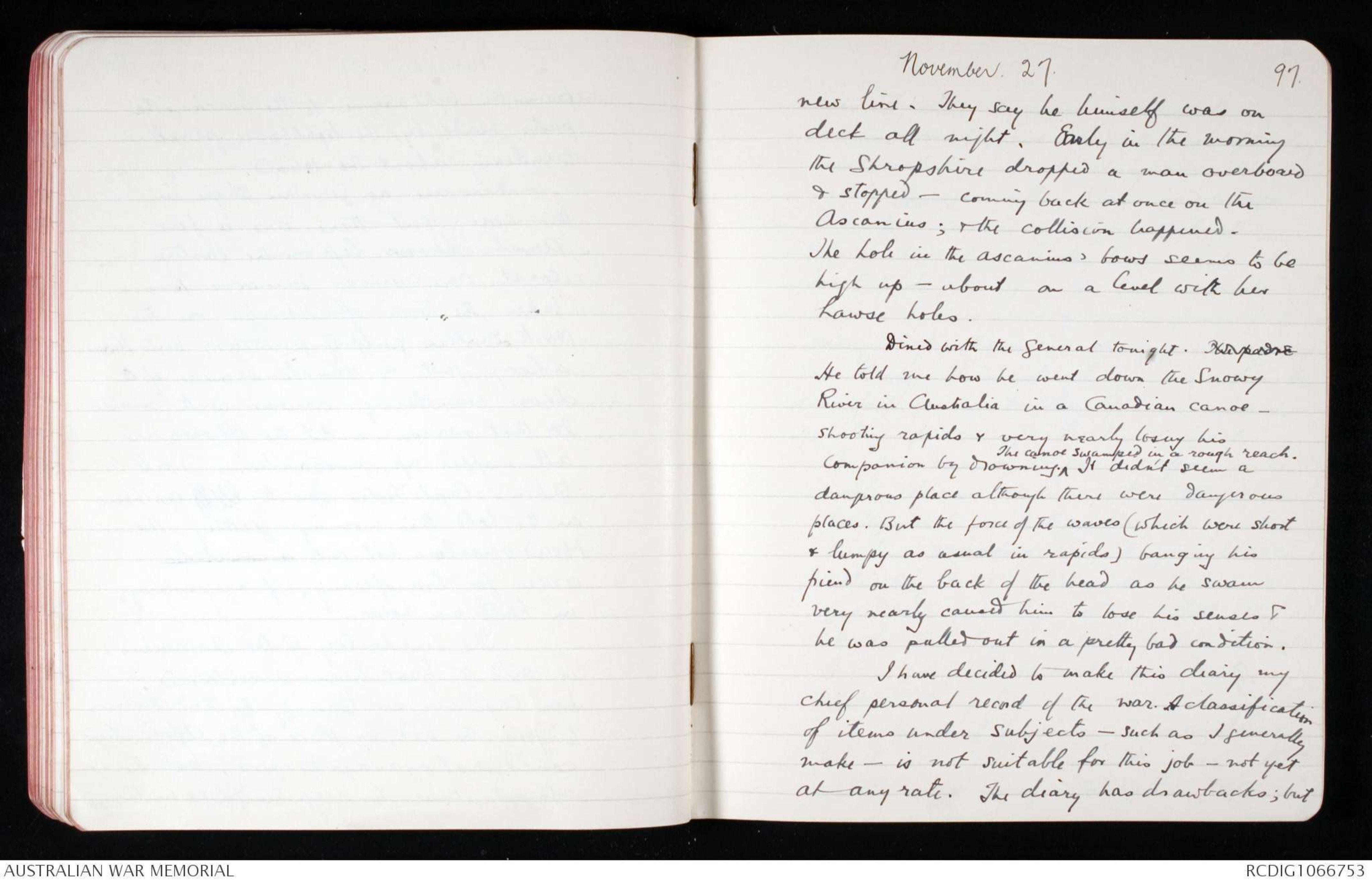
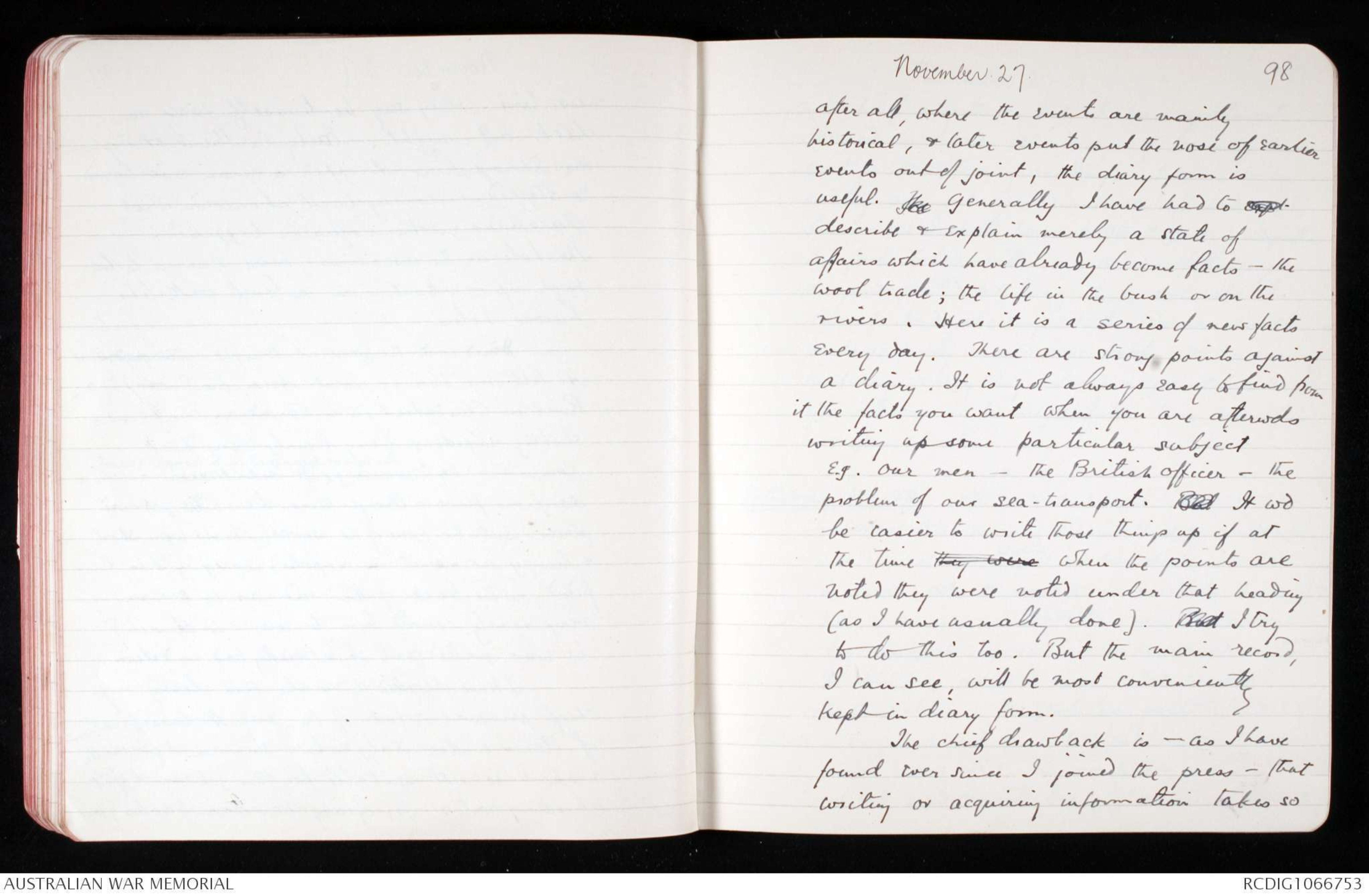
89
November 25.
I dont know if these garrisons are expected to
join up, or whether it is simply a canard; but x
a mobile force of 900 is being formed at Aden in case
of eventualities.
They had a smart little scrap quite close
here the other day. The Turks have a fort at the
Entrance of the Red Sea opposite Perim -at a place
called Sheikh Said - to command the Straits of
Bab-El-Mandeb. One of the Indian Regiments officers in Aden
had just come back from there & he says that
1500 native troops were landed on the beach
whilst the Duke of Edinburgh xx - an armoured
cruiser brought from the Mediterranean - shelled
the fort. The cruisers guns could do very
little because the shot she was far below the
fort which is high up on the hills; the
shells that exploded in the earth in front of it
didnt matter & those that exploded against
the hills at the back mattered less. In the
intervals up popped the Turkish gun - I believe
there was one modern gun & 4 or 5 old ones -
& blazed away at our troops. After fighting holding
out all day the Turks cleared leaving 3 men
who were taken prisoner. There were 500 Turks
90.
November 25.
& they have cleared into the back hills at the back, -x, I suppose, to Mecca or somewhere. We lost
4 killed & 16 wounded & I believe the Turks
are sd to have lost - according to one account -
nobody; & according to another - 40. They
left behind a lot of ammunition of all sorts
which has been blown up.
This place is about 65 or 70 miles
from Aden; but so clear was the sound of
the firing in Aden that the commandant
there sent out to El Haj to make sure that
nothing was happening there, 20 miles away.
All the morning from 6 to about midday
at intervals of ten minutes the rumbling
of big guns could be clearly heard - the
Duke of Edinburgh's 9.2 guns.
It is said rumoured that there is a battle going
on at his moment in the Sinai Peninsula.Xxxx Some transports with hussars &
Indian troops en route from India to the
front are said to have been switched off
there.
Lunched at club & read papers.
Returned after dinner with Schuler for
another read.
Heat at AdenHere the old Ibuki left us after having done faithful service
during our whole voyage. She siqnalled that she was
leaving us: "Have been ordered to the Pacific. Wish you
good luck." We signalled that we were sorry to
part company & wished her every success.
91
November. 26.
Thurs Nov. 26th. Early this day left Aden with the
whole convoy. New Zealanders at first on
our left in two lines - making 5 lines;
afterwards, when we got near Perim,
they went ahead of us; then the Hampshire;
then our three divisions. The Hampshire is
flying three flags, a penant at the foretruck
a white ensign at the peak, & an enormous
red ensign in the fore rigging just aft
of the foremast about half way up. They say
the explanation is that the white ensign is
so like the german ensign that all British
warships have been ordered to fly the red
ensign as well.
→ Shortly after lunch we sighted Perim
ahead; & on the hills of the mainland just
North of it Schuler & I made out what
we were looking for, the traces of the
fight of last week. Xxxx We could see
several buildings - one right on the top
of the hill, others lower down; & a
rather scarred & raw looking neck
of land - really a smaller hill - between
two of the hills. At the back of them
92
November 26
wound the road which seemed solidly
built. There were some houses, indistinguishable
in the mirage, down on the beach; a battered
& ruined building high up on the hillside,
roof down, windows blackened with recent
fire; lower down was a low square
castellated building with a heap of tumbled
stones by the side of it. And high on theneck between the These were all on the
hills to the right. On the top of the
highest hill, that on the left, was a small
building in ruins. And on the neck
of land between the two - along the crest
where I should say the fort had been -
the earth seemed very much scarred & there
were the unrecognisable remains of some
building or another. On the face of the
hills a quarter of a mile in the background
was one new white scar. The whole place
seemed absolutely deserted. I believe
the troops were first taken round to
a beach at the back from which they might
have spread across the peninsula & cut off
all retreat from the Turkish fort. But it was
Here are two bits of club talk from Aden - probably true;
A Gurkha regiment, which lately passed through,
was landed at Suez & told to entrain for Alexandria.
They were afraid they were going to be done in & left in
Egypt - so they wouldn't leave the ship till they
got a written assurance that they would be
embarked again at the other end.
The Khedive is in Constantinople. It is said
that a German police officer from Egypt was left recently
(when the war broke out) for Constantinople. He
returned presently from Constantinople saying
that he found he was not wanted. His luggagepapers wase seized & plans of the Canal found
on him & also papers implicating several notable
Egyptians. It is said that these Egyptians & two
or three Indian nobles princes have been asked to take
an extended tour on the continent. It is not believed
that the Khedive will ever return to Egypt.
This news came to Aden but was censored.
93.
November 26.
so rough that they could not land there - They
were then taken to a beach at another corner
& it took 6 hours to land them there. They
could not cut the Turks off ^ working from this position
& had to be content with driving them inland.
⇢ Isolated transports returning from Europe have
been passing us all day, quite unescorted.
Most are returned Indian transports. One
of the first was I.75 – we thought we were
pretty good with out 28 transports, but 75!
Just as we were steaming out of Aden we met
a fair sized ship going in; she was steaming
faster than we - I.4; a British India
boat. I read her name - & lo & behold, unless
my eyes very much misled me, it was fathers
old friend the Zembla! The Indian transports
have been very crowded, far more so than ours,
I believe. The Lancashire Fusiliers I believe
lost 3 men on their way from Bom Kurrachee to
Aden. We have only lost 3 or 4 on voyage &
only 150 horses or so (I hear). The New Zealanders
lost 3 men ; one, a doctor, broke his neck
diving into the bath they had rigged up on
deck ^ when crossing the line - so a New Zealander [[?]] me
at Aden.
94.
November 26. 27.
Passed Perim - 2 ships inside; an old wreck off the breakwater
- I think I remember it 18 months ago only it had its funnelFrid. Nov. 27. Passed Jeb & masts then. A steamer
was just entering with a white blue & red flag,
horizontal stripes. This puzzled us ^ some of us at first but I
hear it is the Russian mercantile flag.
Frid. Nov 27. Passed several steamers
today - One the Hampshire went over to &
sailed very close all round her before letting
her go on. Her decks were crowded with
some sort of folk - not likely to be pilgrims
this time of year & yet she carried notransport number painted on her side like all themost transports we have seen so far as I
know have this number. Our The Indian transports
are like the Indian ours, xx painted theirwrx ^ ordinary colour except for a by square in of white containing the
ship's number, bow & stern. The New Zealanders
are all grey & their numbers are
different.
Except for one Japanese steamer,
two French steamers (one little flea which
trades between Aden & Tiboutil & the
Messageries steamer Dupleix) & the
Russian above mentioned, we have not
seen a single ^ merchant flag except the British one
95
November 27.
on these seas. Even the Antiquarian
relics - a little ramshackle blue brig,
& a white brig with a high stern
dating from about 1750 I shd say, &
also a large dhow - which came into
Colombo from the Maldive Islands, native
owned, carried the British flag. Today
quite a number of tramps have passed
us, all British & mostly full.
As we passed Jeb-El-Tir Island
I saw a man in white walk up from
the lighthouse homestead to a building
to the outhouse - I wonder if he was
a Turk. - They are I believe Turkish
lighthouses, manned by Turks but paid
for by the British. It is a horrible
Perhaps they have now been replaced
by Indians. It must be an extraordinary
life on these islands in the Red Sea -
No garden; no greenery. Just a hill of
rock & sand ^ and low dry scrub sticking out of the sea.
A red ochre lighthouse with a white cap.
A neat white house, low & square. One
can see in various parts of the island,
96
November 27.
from the lighthouse to the beach, the
paths made by the lighthouse people
wandering about the island.
There are no german ships in
this sea, but there are a few
Arab dhows left on the Eastern
coast. Our cruiser Minerva has
taken the town of Akaba on the
North Eastern gulf of the sea; but theres
always just a remote chance of a
dhow wandering across with mines.
For that reason, until the dhows are
all mopped up, precautions will be
taken. Capt. Foster spent half an hour
in the hold this morning getting the
Headquarters kit into a condito
order for transferring, if necessary,
in half an hour.
The true history of the Ascanius
is said to have been ascertained.
Her captain on leaving the 2nd division
to join the 3rd, in place of the Afric which
could not manage the pace, took the
utmost care to keep his place in the
97.
November. 27.
new line. They say he himself was on
deck all night. Early in the morning
the Shropshire dropped a man overboard
& stopped - coming back at once on the
Ascanius; & the collision happened.
The hole in the Ascanius' bows seems to be
high up - about on a level with her
hawse holes.
Dined with the general tonight. The padre
He told me how he went down the Snowy
River in Australia in a Canadian canoe -
shooting rapids & very nearly losing his
companion by drowning. ^ The canoe swamped in a rough reach. It didn't seem a
dangerous place although there were dangerous
places. But the force of the waves (which were short
& lumpy as usual in rapids) banging his
friend on the back of the head as he swam
very nearly caused him to lose his senses &
he was pulled out in a pretty bad condition.
I have decided to make this diary my
chief personal record of the war. A classification
of items under subjects - such as I generally
make - is not suitable for this job – not yet
at any rate. The diary has drawbacks; but
98
November. 27.
after all, where the events are mainly
historical, & later events put the nose of earlier
events out of joint, the diary form is
useful. The Generally I have had to
describe & explain merely a state of
affairs which have already become facts - the
wool trade; the life in the bush or on the
rivers. Here it is a series of new facts
every day. There are strong points against
a diary. It is not always easy to find from
it the facts you want when you are afterwds
writing up some particular subject
E.g. Our men - the British officer - the
problem of our sea-transport. But It wd
be easier to write those things up if at
the time they were when the points are
noted they were noted under that heading
(as I have usually done]. But I try
to do this too. But the main record,
I can see, will be most conveniently
kept in diary form.
The chief drawback is - as I have
found ever since I joined the press - that
writing or acquiring information takes so
 Loretta Corbett
Loretta CorbettThis transcription item is now locked to you for editing. To release the lock either Save your changes or Cancel.
This lock will be automatically released after 60 minutes of inactivity.